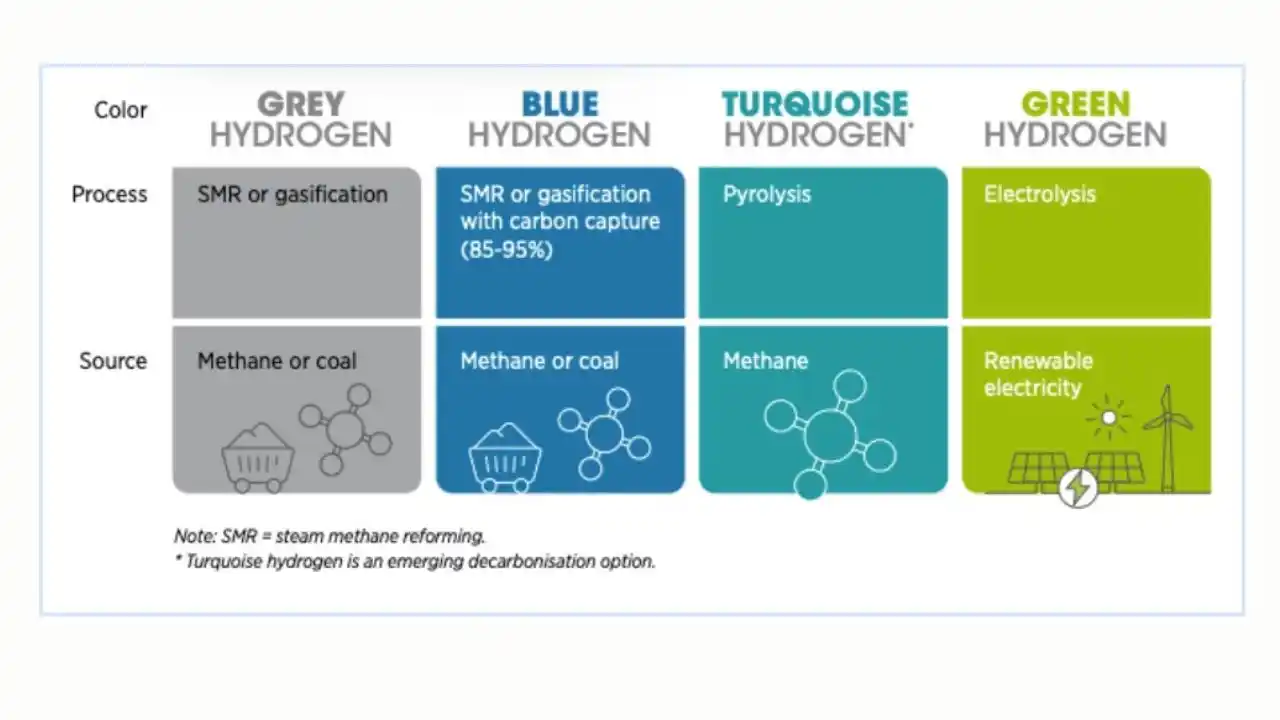Net zero emissions targets can be achieved only by diversifying the clean energy portfolio. Along with other renewable energy sources such as solar energy, wind energy, tidal energy, geothermal energy, and water energy, green hydrogen is an untapped clean energy resource. Having said that in this blog post, we are going to discuss green hydrogen and how it can be used to mitigate climate change.
So, let’s dive right in.
What is Hydrogen Fuel and How Is It Produced?
The lightest element “Hydrogen” is used to produce energy by burning it the same way as natural gas and oil are combusted. Similar is the working of fuel cells, in which a reaction of hydrogen and oxygen can produce electricity.
Hydrogen fuel is mostly produced through the process known as Steam Methane Reforming (SMR). In this process, methane reacts with high-pressure steam and produces three products namely carbon dioxide, carbon monoxide, and hydrogen.
One thing is important to note is that methane used in the process is the main component of fossil fuel, therefore, the International Energy Agency (IEA) believes that the production of hydrogen depends on fossil fuels entirely.
The concept of hydrogen energy came into the limelight through an unfortunate incident, i.e., exploding of Hindenburg airship on 6th May 1937 killing 35 people.
The inflammable gas hydrogen was the cause of the incident. The accident was also captured on film.
Types of Hydrogen Fuels
Hydrogen fuels are classified through the color spectrum depending upon the source from which hydrogen is produced.
For instance, blue hydrogen is produced from methane or coal through the process of SMR (Steam Methane Reforming) or gasification with carbon capture and storage.
Gray hydrogen is also produced from the same process and material as blue hydrogen. But there is a variation in carbon dioxide produced.
Turquoise hydrogen is produced from methane through the process of Pyrolysis, while green hydrogen is the clean one which is produced by breaking water into oxygen and hydrogen (Electrolysis).
The process is carried out using renewable energy sources. Hence, green hydrogen is totally clean to use and has no environmental impacts. But the process is currently very expensive to be implemented on a wider scale.
Other hydrogen fuels include Brown and black hydrogen produced from coal. The pink hydrogen is produced when the electricity for electrolysis comes from nuclear power. Hydrogen fuel types and their manufacturing processes are given in the picture below:

Can Hydrogen Fuel Replace Fossil Fuels?
The answer to this question is relative, well that depends on how the energy is produced and from what sources it is extracted.
Moreover, the cost is another constraint, usually, hydrogen fuel is produced at a high cost. Despite the limitations, according to the IEA’s The future of hydrogen report, the global demand for hydrogen fuel has tripled since 1975.
To make hydrogen fuel more environmentally friendly, countries like the US, the Netherlands, the UK, and Canada have direct huge investments in blue hydrogen technology.
You May Also Read: Jackery Solar Generators Reviews: Jackery 2000 Pro, 1500, and More
Advantages of Green Hydrogen Energy Solutions
Realizing the potential, the World Economic Forum (WEF) has declared hydrogen as the fuel of the future. Hydrogen fuel offers many advantages and promises to replace fossil fuels and help mitigate climate change.
Let list some other advantages of using hydrogen fuel, particularly the green one:
- A hydrogen fuel cell only produced clean water as emissions. That’s right, you get good clean water.
- This fuel is environmental friendly with low emission levels to help achieve net-zero goals (But only when produced using renewable feedstock otherwise the emissions are very high)
- Hydrogen technology has a long range on a single refueling
- Hydrogen fuel has the potential to replace fossil fuels only when produced by electrolysis (Breaking of water into oxygen and hydrogen)
- Hydrogen can also be used to store and transport energy
- It is a great tool to boost sustainable construction practices by transforming heavy industries, such as the cement and steel industries.
The Transition to a Green Hydrogen Economy
The benefits of green hydrogen fuel can be achieved through the widespread deployment of electrolyzers to scale up the technology.
Achieving this requires sound policy making and sufficient investment. Moreover, pipelines should be installed for the transportation of fuel from one place to another.
Several governments and organizations are currently working towards the achievement of net-zero emissions through promoting hydrogen fuel and have included green hydrogen technologies in their national strategies.
Take for instance the example of the United Nations which has announced an initiative “The Green Hydrogen Catapult” to bring down the cost of fuel production.
Another major progress towards the green hydrogen economy is the signing of a major infrastructure law in 2021. It includes an $8 billion package for at least four hydrogen hubs to produce and store clean hydrogen energy.
Moreover, the recent REPowerEU energy policy also proposes an import of 10 million tons of green hydrogen in addition to the 10 million tons produced domestically. The policy has set goals for rapid transitioning towards clean energy as a response to the current energy crisis in Europe.
Japan has also joined the squad with its recent announcement of a $3.4 billion investment to accelerate green innovation research and the development of hydrogen in the coming decade.
You May Also Read: 10+ Best Solar Generators for Off-Grid Living
Applications of Green Hydrogen Systems
The application scenario of hydrogen fuel is very wide-ranging from heating to powering airplanes. Hydrogen is already in use for a number of applications such as:
- Glass purification
- Petroleum refining
- Fertilizer production
- In Aerospace industry
- Welding, heat-treating metals
- Semiconductors production
Furthermore, the first commercial hydrogen cell-powered automobile (Hyundai Tucson FCEV succeeded by Hyundai Nexo) was manufactured in 2013.
Later in 2014, Toyota entered the market followed by Honda. In the 2022 Beijing Olympic Winters games, hundreds of hydrogen fuel-cell buses were used.
Hydrogen has also been tested on other vehicles i.e., boats, spaceships, submarines, aircraft, space rockets, etc.
In the future, if harnessed properly, the application of green hydrogen fuel will be extended to any place where energy is used. Hence, eco-friendly hydrogen energy is a tool to reduce our dependency on fossil fuels and achieve net-zero emissions.
You May Also Read: 7 Sustainable & Biodegradable Liquid HandSoaps You NEED in Your Bathroom
Conclusion
I hope there is no confusion left regarding the potential hydrogen fuels have to offer. The government should use public procurement and purchase incentives to boost the demand.
Moreover, the government should also encourage private investment in the sector.
There is also a need for policymaking to maximize the benefits of hydrogen energy and hydrogen-embedded products.
You May Also Read: Your Ultimate Guide to the Best Biodegradable Gloves: Top 9 Picks


2 thoughts on “Harnessing Green Hydrogen: A Viable Alternative to Replace Fossil Fuels”
Comments are closed.